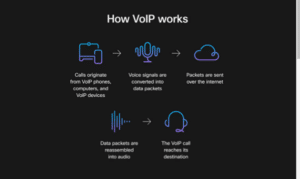
The Role of VoIP in the Future of Work and Remote Communication
June 11, 2025It’s no secret that the world of work is changing. More and more people are working remotely, and this trend will continue. It means your employees will spend less time in the office with you, making it challenging to collaborate as a team. A VoIP phone (Voice over Internet Protocol) allows you to communicate with your employees remotely. It can help keep everyone on the same page even if they are not physically present at meetings or other events.
From enabling remote work to improving communication, VoIP phones for business are shaking up how we work and communicate in the 21st century. With a VoIP phone, employees across distances can cut the cord and take their conversations global. They can collaborate in real time while enjoying cost-saving benefits like free calls and unlimited texting. VoIP is not just the future of work– it is already here and reforms how we stay connected!
In this blog post, we will explore how the service is changing how we work remotely and communicate with each other.
The Role of VoIP in the Future of Work and Remote Communication
The future of VoIP is here, and it’s not what you think. It’s not a call with a robotic voice that tells you to press “1” if you want to speak to a human.
So what is VoIP? It stands for Voice over Internet Protocol and is another way to make phone calls using your computer or mobile device. Instead of using traditional landlines, you can use your VoIP phone to send voice signals from one computer to another. It makes it possible for you to talk with anyone with access to an internet connection. Since most people have access today, you can connect with practically anyone on Earth!
The future of VoIP will involve two main things; improved quality and lower VoIP service costs.
Increasing demand for unified communications
Providers have made remote communication more seamless than ever. We can attribute this to the increasing demand for unified communications (UC). Unified communications is an umbrella term for multiple communication tools like phone calls, emails, voice messages and many more.
It can include email, instant messaging and video conferencing—all integrated into a single system.
To understand how VoIP fits into this picture, we need to look at how UC works today:
- Email is king with internal communication within an organization.
- Instant messaging has become more commonplace when communicating with absent coworkers. However, many people still have separate IM accounts for work and personal use.
- Video conferencing has become a common way to meet with colleagues while working remotely.
A VoIP phone is the perfect solution for unified communications in remote working. It enables organizations to connect managers, employees, and customers seamlessly and cost-effectively. Service providers offer more than just audio-visual communication. VoIP phone service also unifies all aspects of communication, regardless of location.

5G-improved quality of service
The role of VoIP communication in the future of work is invaluable. 5G technology allows for a massive leap forward in VoIP quality, with dramatically improved connection speeds, sound clarity and lower latency. Not to mention, businesses can benefit from the cost savings associated with VoIP too. It all adds up to an enhanced remote working experience. It will change how we work, making remote communication faster, easier and more efficient.
Interactive voice response (IVR)
The VoIP phone has an interactive voice response (IVR) technology that has revolutionized how we do business. IVR lets organizations interact directly with customers without a receptionist or other staff. This feature gives companies more flexibility and cost efficiency. By using IVR, customers can access information more quicker and easier. While businesses can streamline customer service operations, and workers can stay connected on the go.
The IVR system is an AI tool that allows businesses to provide callers/customers with information without speaking to a human representative. It processes and answers customer questions. Then, transfers the caller to the company rep for more detail.
Artificial intelligence (AI) in VoIP
With AI-powered VoIP, businesses can maximize their communication capabilities with existing and potential customers. A VoIP phone uses sophisticated algorithms to offer an enhanced communication experience. It can do this by recognizing speech patterns and understanding context. It ensures that the conversations are smoother, more natural, and more efficient. AI-driven VoIP phone service also makes it easier for workers to access customer information from multiple locations. Thus, it enables them to provide better support in shorter time frames. The ability of AI-enabled VoIP to create more effective platforms for employees to work remotely will restructure how brands do business in the future.
Voice-to-text
Voice-to-text technology works with speech recognition software that can convert spoken words into text. The idea behind this approach is simple. If you can listen to someone or something, you can write what they say without having to write it down manually first! That’s where speech recognition comes in handy. It allows you to convert speech into text at incredible speeds and accuracy without extra hardware like headsets or microphones.
Omnichannel
Service providers will continue to reform the future of work and remote communication. The technology allows for a multi-channelled approach to conversations. It helps you move seamlessly between messaging and social media channels. It means employees can communicate easily with each other, no matter where they are in the world. A VoIP phone’s flexibility allows businesses to scale up quickly and easily. The VoIP phone caters to their growing needs without compromising quality or customer service. With VoIP, the future of remote communication looks brighter than ever.
Conclusion
VoIP communication has made our lives easier and more convenient. It has also changed how we communicate with colleagues, friends, and family. VoIP providers provide a reliable and secure solution that allows you to communicate wherever you are without hiccups.
VoIP is the best solution for remote communication in the future because it provides high-quality voice calls with minimal latency. It also offers several features like call forwarding and call conferencing, which can be very useful in different situations.
A VoIP phone is an incredible asset for businesses and allows you to expand your reach.
It also offers better customer service to those who might not have access to such services. VoIP phone has also allowed workers to spend more time on personal projects or tasks to achieve self-fulfilment.
Related News


4 min read


6 min read


7 min read